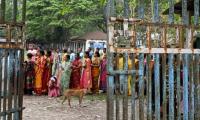iThe prestigious international journal, ‘Nature’, (UK) recently published an article titled ‘Institutions: Revive universities of the Muslim world’, in which the authors were critical of the universities in the Muslim world. The general perception is that no university in the Muslim world is in the top 500 universities of the world. However, nothing is further from the truth.
There are at least three universities from the Muslim world that are currently listed in the top 250 universities of the world as per the QS World Universities Ranking 2015-16. These include one from Malaysia and two from Saudi Arabia. If the range is expanded to the top 500 universities, then 23 universities are listed (Turkey and Malaysia at five each, Saudi Arabia and the UAE at three each, Indonesia and Kazakhstan at two each, and Egypt, Lebanon and Qatar at one each).
While a number of universities from the Muslim world have fared well, including from smaller countries like the UAE and Qatar, and war-torn Lebanon, no university from Pakistan has made it to the top 500 universities of the world.
However, in the QS Top 250 Asian Universities 2015, Malaysia has 14 universities, Pakistan has seven, and Indonesia six. Turkey and certain Muslim countries from the top 500 list were excluded from the Asian region, otherwise the numbers from Pakistan would have fallen further to less than seven. When I served as chairman of the HEC, 10 Pakistan universities were listed in the top 250 Asian Universities in 2014, up from seven in 2013, six in 2002, four in 2011 and none in 2010 when I was first appointed. It appears that not only has the number of top ranked universities from Pakistan started going down, despite an increase in funding, but those from other Muslim countries are going up.
Of the universities in the Muslim world, the Middle East Technical University is the only one that was ever ranked previously in the top 100 by Times Higher Education Ranking 2014. There are also new upcoming stars in addition to the universities listed in the top 500, including the King Abdullah University of Science and Technology in Saudi Arabia, and the Masdar Institute in UAE.
In other indicators, in the 2015-16 World Economic Forum Global Competitiveness Report, under the heads of Higher Education and Training, certain Muslim countries have again fared well and are in the top 50: Qatar (27), Malaysia (36), UAE (37), Saudi Arabia (49) and Jordan (50). Pakistan’s ranking is way down at 128, but it was ranked slightly better at 124 few years ago. Here too, we seem to be sliding downwards.
If we study another indicator, Scopus, which is the largest abstract and citation database of peer-reviewed literature, then as per Scimago 2014 global publication data, which is a portal that includes the journals from the Scopus database, Iran ranks number 16, Turkey 19 and Malaysia 23 (all ahead of Scandinavian countries, Switzerland, Taiwan, South Africa, Israel and Singapore). Saudi Arabia ranks 35 and Pakistan 43.
What is again disappointing is that the number of research publications from Pakistan has dropped from 11,168 in 2013 to 10,541 in 2014. In 2013, Scimago had also forecast that if Pakistan continues to publish at the then current pace, its rank will move up from 43 to 27! This was clearly not meant to be, as the number of publications out of Pakistan has dropped since then.
Many universities in the Muslim world are seeking US accreditation for global recognition. For example, the prestigious US business accreditation body Association to Advance Collegiate Schools of Business (AACSB) has accredited at least five universities in the UAE, three each in Turkey and Saudi Arabia, two in Malaysia, and one each in Qatar, Lebanon, Egypt and Kuwait, while there are none in Pakistan.
Similarly, the US Accreditation Board for Engineering and Technology (ABET) has accredited at least 12 universities in Saudi Arabia, 11 in the UAE, five in Turkey, two each in Qatar and Bahrain, one in Oman and even one in the Palestine State, while there are no ABET-accredited engineering universities in Pakistan.
In addition to the above, some local accreditation bodies have even higher standards than US bodies. For example, the accreditation standards of the UAE are far more stringent than those of ABET. The UAE requires all faculty to have a PhD degree, while the ABET only requires appropriate qualifications.
It is therefore very unfortunate that Pakistan not only lags behind the developed world, but also the region as well (India has nine universities in the top 500 universities of the world), and now we are falling behind the Muslim world as well, despite hundreds of billions spent on the higher education sector.
So what has gone wrong, and how can we do better? We can’t analyse all the weaknesses and threats in a few words, but clearly at the top of the list is political interference within the higher education sector, including in the appointment of vice chancellors.
The second is the quality of faculty, where only a PhD degree should be a requirement for appointment or continuation. Third, we need to focus on quality rather than quantity, and resist the demand of every minister wanting to open a university, or upgrade a college, in his or her area. Fourth, all academic programmes should not only be approved by a team of international experts but accredited by an international body as well. Fifth, all scholarships for PhD or post-doctoral work should only be to top 100 universities, so that the faculty understand what ‘world-class university’ means.
The universities in the Muslim world have woken up, and seeds have already been sown for the next decade to be the age of knowledge economy and innovation. Can Pakistan afford to lag behind?
The writer is a former chairman of the Higher Education Commission.
Email: jlaghari@gmail.com
A woman walks past a building of the International Monetary Fund. — AFP/FileThe annual and spring meetings of the...
Late Benazir Bhutto's daughter Asifa Bhutto Zardari addresses the Christian community in Bihar Colony on January 23,...
Representational image. — PexelsWater is an important scarce natural resource that is required for several everyday...
Pakistani employees of online marketplace company Kaymu at work in Karachi. — AFP/FileThe true spirit of development...
India uses Afghanistan as a backstage area to carry out terrorist attacks against Pakistan
Another report by the Pakistan Institute of Peace Studies states that 78 per cent of attacks have been carried out by...







